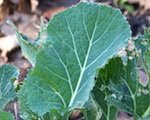Collard greens can be grown in spring or fall, but the fall crop tends to be more sweeter and flavorful..

No form of greens is superior to the collard. It's vitamin and mineral content is fully equal to that of spinach, turnip greens, mustard, and kale and higher than that of cabbage, broccoli, and cauliflower. Collard greens also contains more protein, carbohydrates, and fats.
Collards will stand much more cold than cabbage. By covering with sacks, pine brush, or other material during very hard freezes, it may be carried through almost anywhere in the South. Ordinary or light freezes improve its flavor, and no covering should be given until the temperature drops down to 10 or 15 degrees above zero.
While collard greens are mainly a winter vegetable, many like it as spring or early-summer greens, though it's not nearly as sweet and tasty. For an early crop, sow seed or set plants when the early cabbage are planted.
Prepare ground, fertilize, and cultivate as for cabbage. Plants may be set thickly in the row, 5 to 8 inches apart. Let them grow into small bunchy plants like kale, or set 18 to 24 inches apart and allow to produce large stalks or plants.
For the winter crop, plant seed in late June, July, or August, either in beds for transplanting later or in rows where it is to grow. Many prefer the latter plan because it avoids the necessity of transplanting during hot, dry weather.
When planted where it is to grow, sow seed thinly and block out to three to five plants in hills 18 to 24 inches apart when up and growing well. Later thin to one plant, using the thinings for setting elsewhere. By putting water in the trench before seed is sowed, as out-lined for cabbage, a stand can usually be had regardless of how hot and dry the weather may be.
Instead of thinning summer plantings by blocking out plants, many commercial growers let them stand until large enough to begin using and let cuttings thin to the desired distance. The single-plant method is best for spring planting.
Like all leafy vegetables, collard needs a rich soil. Liberal feeding will not only make it grow larger but more rapidly, which means much better quality.
